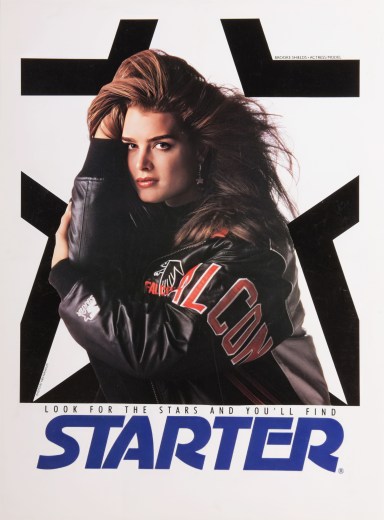This story is part of Glossy’s Return to Analog series, focused on the fashion and beauty brands embracing all things analog and retro, including those eschewing social media marketing or AI and those embracing traditional crafts or print media.
In the current marketing landscape, digital is decidedly king, but surprisingly, a growing number of brands are relying on analog channels to resonate with consumers.
“[Analog marketing] speaks to the consumer. It touches them. It allows the consumer to be in touch emotionally,” said Carl Banks, president of G-III Apparel Group, which owns brands including DKNY and the licenses of brands including Starter. Banks, who has been with G-III Apparel Group since 1985, said he’s seen many iterations of Starter, from its peak in the ’90s, when the brand brought in nearly $360 million in revenue, to its low point, when it filed for bankruptcy in 1999.
Now, as Banks works to rebuild Starter, he’s striving to evoke the brand’s essence in its ’90s heyday to acquire a new wave of consumers. The key, he said, is traditional marketing. In the ’90s, consumers could find Starter present at nearly every hip-hop and sporting event. In addition, the brand outfitted public figures, including Brooke Shields, Will Smith and Missy Elliot, in its bestselling satin bubble coat, cementing the jacket’s cult status.

“The digital space is crowded and attention spans are not there. So, how do you get someone’s attention when they are only giving you 15-25 seconds?” Banks said.
One way Starter is answering this challenge is by rebuilding its street team and reprioritizing wild postings in unconventional locations like construction sites.
Ad position: web_incontent_pos1
In addition, it’s increasingly showing up at big cultural events. Already this year, Starter has partnered with the NFL to host IRL moments at rapper Tyler, the Creator’s Camp Flog Gnaw music festival in L.A. and the Super Bowl in Las Vegas. At both events, Starter ran pop-up booths where consumers could purchase and enter to win Starter jackets. Banks shared that, in July, Starter will collaborate with a yet-to-be-announced multi-disciplinary artist at NBA Con in Las Vegas — they’ll customize Starter jackets with graffiti art, embroidery and pins on site. The brand will also introduce limited-edition catalogs later this year. According to previous Glossy reporting, in 2023, Starter increased its sales by 20% year-over-year.
Meanwhile, other brands are tapping into nostalgia through imagery and cultural moments.
For example, in March, Gap partnered with London-based skateboarding and clothing label Palace to launch the Palace Gap collection. The campaign for the collection was a direct nod to ’90s skateboarding culture. The 90-second video spot featured prominent public figures of that era, such as the Spice Girls’ Melanie C, and skate legends Elissa Steamer, Karl Watson and Tommy Guerrero.
Ad position: web_incontent_pos2
The Palace Gap collaboration is the latest in a string of ’90s and nostalgia-inspired marketing from Gap. Under newly-appointed CEO Richard Dickson, who joined the company in August 2023, the retailer has been on a mission to revamp its image. Gap went viral on TikTok in early March for the debut of the first asset for its “Lined Moves” campaign, starring South African pop star Tyla. The video, featuring the viral “Back on 74” single by Jungle, was equal parts nostalgic and timely — a winning consumer acquisition strategy for brands that can get it right. The post has 25 million views and 374,200 likes, as of Thursday.
Overall, Gap appears to be gravitating to “low-res” imagery and videos reflecting the rawness and authenticity that catapulted the popularity of TikTok. According to Banks, authentic emotional connection with consumers will ultimately turn clicks into sales.
Its fourth-quarter of 2023 earnings, reported on March 7, revealed net sales of $1.01 billion, down 5% compared to last year. The company didn’t respond to a request for comment.
Beauty is also going the nostalgic route. To promote a rare brand sale — it only discounts during a leap year — the 28-year-old “clean” skin-care brand OSEA rolled out a ’90s-inspired campaign that proved to be its most successful campaign yet, said co-founder Melissa Palmer.
In addition to reverting its products’ prices to the amount they were sold for at the brand’s 1996 launch, OSEA tapped 400 influencers to promote the event. It also redesigned the homepage of its website to be ’90s-themed — a sticker bank, ’90s background music and a new color palette were featured. The brand also released its first-ever piece of apparel: a ’90s-inspired sweatshirt.

The results surpassed the founder’s expectations. “We had our highest and second-highest sales days in our company’s history,” Palmer said, adding that the organic and social posts from the influencer translated to 2.7 million in reach and 250,000 impressions on social. “[Moving forward], we’ll [use] nostalgia to focus on our history. Our customers and influencers are typically surprised to find out we’re 28 years old,” she said.
Nostalgia continues to prove its marketing power. Millennials’ and Gen Zalpha’s desires for items from the past have given many heritage brands new opportunities to connect through nostalgic imagery, product launches — or relaunches, campaigns and marketing activations.
“In today’s culture, everyone has a high filter for B.S. For brands to truly and successfully tap into ’90s and nostalgia, they have to connect it to a piece of their core story that’s like deeply true,” Palmer said.




